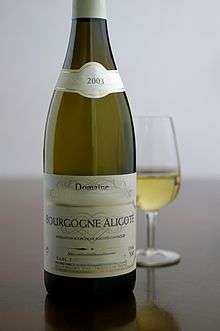Aligoté
Aligoté is a white grape used to make dry white wines, especially in the Burgundy region of France where it was first recorded in the 18th century.[1] Since it is tolerant to cold, this variety is also cultivated in Eastern European countries. In 2004, it was the 22nd most planted vine variety in the world at 45,000 hectares (110,000 acres).[2]
| Aligoté | |
|---|---|
| Grape (Vitis) | |
| Color of berry skin | Blanc |
| Species | Vitis vinifera |
| Also called | Blanc de Troyes, Vert blanc, Chaudenet gris, Plant gris, and other synonyms |
| Origin | France |
| Notable regions | (see major regions) |
| VIVC number | 312 |
Description
Aligoté is used to produce a varietal white wine, and is sometimes included in the blend of Burgundian sparkling wine known as Crémant de Bourgogne. In the varietal appellation Bourgogne Aligoté AOC, up to 15% Chardonnay grapes may be blended in.[3] Traditionally, the cocktail kir (also known as vin blanc cassis in French) is made by adding cassis to an Aligoté wine. In blends, Aligoté adds acidity and structure to other varieties.[4] It is often blended with Sacy for this purpose.[5]
The grape ripens early with moderate yields and produces wines high in acidity that can be drunk young. Its aroma includes elements of apples and lemons.[3] Clive Coates says it is a variety of secondary importance in Burgundy which produces a light, primeur-style wine with slightly herbal flavour and rather higher acidity than the Chardonnay.[6] The village of Bouzeron is considered to represent the region's finest examples of the variety[3] with the appellation Bouzeron-Aligoté AOC restricting the yields to 45 hl/ha compared to the Bourgogne Aligoté AOC limited to 60 hl/ha.[1]
Regional production

The grape is the second most popular white grape variety grown in Burgundy after Chardonnay, though it lies a long way behind in terms of planted area, with 1,700 hectares (4,200 acres)[7] against 12,800 hectares (32,000 acres).[8] The vines were once inter-planted and field blended with Chardonnay for the benefit of added acidity but the vines have long since been separated.[9] Aligoté often loses territory to more prestigious grape varieties and in some areas is relegated to less productive vineyard sections at the tops and bottoms of the slopes.[1] In Burgundy the grape can be found along the fringe edges of the Côte-d'Or along Route Nationale 74, as well as in Mâconnais and Côte Chalonnaise.[10] There are also small plantings just east of the Rhone Valley around the city Die and in the commune of Pierrevert in the Alpes-de-Haute-Provence.[9] It has its own AOC's, Bourgogne Aligoté and Bouzeron.
Aligoté is also produced in Eastern European countries,[4] including Ukraine, Bulgaria, Romania, Switzerland and Moldova. In Bulgaria, the grape is prized for its blending qualities and high acid; the quantity of Aligoté planted in Bulgaria is more than twice that in the grape's ancestral home of Burgundy.[10] The grape is primarily found in the Stara Zagora Province around Chirpan.[10] In Russia, it is used to make sparkling wines[4] with varietal wines being made along the coast of the Black Sea around Gelendzhik.[11]
Globally, Aligoté can be found in smaller plantings. It has been produced, though in very small quantity, by Australian wineries.[4] In the United States, the wine is grown in Washington State, since it is resistant to the cold weather, and in California, where it is used mostly for blending. There have also been small, experimental plantings in Chile.[9] In Canada, the grape is grown in Niagara by Chateau de Charmes.
Origins
DNA fingerprinting has found Aligoté to be a crossing of Pinot noir and Gouais blanc, which is an ancestry which is consistent with an origin in Burgundy or nearby areas of eastern France.[12][13]
Synonyms
Synonyms for Aligoté include Aligotay, Alligotay, Alligoté, Blanc de Troyes, Carcairone blanc, Carcarone, Carchierone, Chaudenet, Chaudenet Gras, Giboudot blanc, Griset blanc, Karkarone Blank, Melon de Jura, Muhranuli, Mukhranudi, Pistone, Plant de Trois, Plant de Trois Raisins, Plant gris, Purion blanc, Selon Molon, Selon Odart, Troyen blanc, Vert blanc.[13]
References
- winepros.com.au. Oxford Companion to Wine. "Aligoté". Archived from the original on 2008-08-08. Retrieved 2008-10-06.
- Jancis Robinson, ed. (2006). "Vine varieties". Oxford Companion to Wine (Third ed.). Oxford: Oxford University Press. pp. 746. ISBN 0-19-860990-6.
- "Bourgogne Aligote". terroir-france.com. Terroir-France, French Wine Guide. Retrieved 2018-03-20.
- Aligote a high acid white wine variety
- J. Robinson Vines, Grapes & Wines pg 232 Mitchell Beazley 1986 ISBN 1-85732-999-6
- C.Coates 'Encyclopedia of the Wines and Domaines of France pg 32 Cassel & Co 2000 ISBN 0-304-35441-4
- Burgundy Wines - Grape varieties: The Aligoté grape, accessed October 28, 2008
- Burgundy Wines - Grape varieties: The Chardonnay grape, accessed October 28, 2008
- Oz Clarke Encyclopedia of Grapes pg 35 Harcourt Books 2001 ISBN 0-15-100714-4
- J. Robinson Vines, Grapes & Wines pg 179 Mitchell Beazley 1986 ISBN 1-85732-999-6
- C. Fallis The Encyclopedic Atlas of Wine pg 380 Global Book Publishing 2004 ISBN 1-74048-050-3
- Oz Clarke Encyclopedia of Grapes pg 112 Harcourt Books 2001 ISBN 0-15-100714-4
- Vitis International Variety Catalogue: Aligote Archived 2011-07-19 at the Wayback Machine, accessed on June 18, 2008